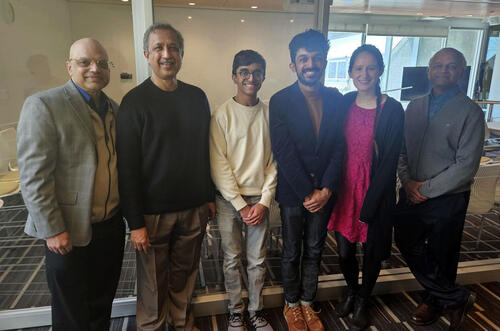
On April 3, 2023, Rajeev Erramilli successfully defended the thesis “Bootstrapping Fermionic Conformal Field Theories” (advisor: David Poland).
Erramilli explained, “Theoretical physics is, to me, the craft of finding mathematical patterns in the universe and seeing how they can improve our models and theories of the universe. My thesis involved what’s called the “bootstrap” approach, which takes this picture of theory to the extreme: can just those mathematical patterns let us bootstrap up a complete understanding of some physics, no extra information required? When the mathematical patterns are those of conformal field theories (CFTs), the answer is, shockingly, yes! CFTs are abstract but appear all over physics in our theories for the phases of matter to the fundamental particles of the universe to even a hypothesized description of a quantum theory of gravity. The abstraction comes with a lot of very powerful math, it turns out. With just a few mathematical assumptions – that is to say, assumed patterns – the conformal bootstrap (as it’s called) is able to completely and precisely determine the physics of CFTs, at least in a few simple cases so far. My work involved developing this conformal bootstrap method further, including building the software tools blocks_3d and hyperion-bootstrap. With our new tools, we were able to newly solve with best-in-the-world precision a family of CFTs known as the O(N) Gross-Neveu-Yukawa CFTs, which describe possible quantum phase transitions in graphene, topological superconductors, and superfluid helium-3. But to me, I’m excited because our results show the continuing unreasonable effectiveness of math in physics. I’m hopeful that someday we’ll be able to extend these lessons to any CFT and learn significant things about every realm of physics they touch.”
In the Fall Erramilli will be starting a postdoctoral position at L’Institut des Hautes Études Scientifiques (IHÉS) in France.
Thesis abstract:
I present the design, development, and application of new technology for the conformal bootstrap in the context of the study of three-dimensional conformal field theories (CFTs) with fermionic operators, as well as an exploration of the bootstrap of a fermionic gauge CFT. In doing so, we find world-record-precision rigorous bounds on the critical exponents and OPE coefficients of the O(N) Gross-Neveu-Yukawa (GNY) family of CFTs for N=2,4,8 as well as significant progress in the bootstrap of Quantum Electrodynamics in 2+1 dimensions (QED3). First, we derive closed-form expressions for all ingredients of the Zamolodchikov-like recursion relation for general spinning conformal blocks in 3-dimensional CFT. Our derivation is based on an understanding of null states and conformally-invariant differential operators in momentum space, combined with a careful choice of the relevant tensor structures bases. Based on this result, we then design an algorithm for these conformal block computations to compute conformal blocks for correlation functions of operators of general spin without ad-hoc computations, representing an improvement over previous efforts. This algorithm is implemented as a heavily optimized, multithreaded, C++ application, blocks_3d. We then use blocks_3d to perform a bootstrap analysis using supercomputing clusters of a mixed system of four-point functions of bosonic and fermionic operators providing rigorous bounds on the scaling dimensions of the O(N) GNY fixed points and constraining these theories to live in isolated islands in the space of CFT data. We focus on the cases N=1,2,4,8, which have applications to phase transitions in condensed matter systems, and compare our bounds to previous analytical and numerical results. Finally, we perform a bootstrap analysis of critical Nf=4 QED3, a theory of fermions with a U(1) gauge field. Notably, we constrain the scaling dimensions of the leading fermion bilinear and leading monopole operator to a closed island, suggesting that our large-Nf-inspired assumptions can form a self-consistent CFT despite not being strictly justified.
See below for link to flickr album.